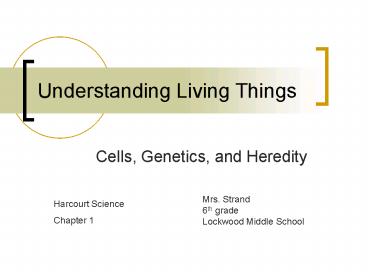Understanding Living Things - PowerPoint PPT Presentation
1 / 22
Title:
Understanding Living Things
Description:
Title: Understanding Living Things Author: Nancy Last modified by: Pam Richau Created Date: 9/8/2004 1:06:48 AM Document presentation format: On-screen Show – PowerPoint PPT presentation
Number of Views:64
Avg rating:3.0/5.0
Title: Understanding Living Things
1
Understanding Living Things
- Cells, Genetics, and Heredity
Mrs. Strand 6th grade Lockwood Middle School
Harcourt Science Chapter 1
2
Cells, Genetics and Heredity
- Terms
- Cell membrane
- Cell wall
- Cytoplasm
- Mitochondria
- Chloroplast
- Vacuole
- Nucleus
- Chromosome
- Nuclear Membrane
3
How Plants Animal Cells Differ
- The discovery of cells
- Robert Hooke
- One of the first people to see and study the tiny
building blocks that made up living things - Gave cells their name, because they looked like
small prison cells
4
Cell Theory
- Cells are the basic building blocks of all living
things - Large organisms have more cells that can do
different things - All live activities take place in cells
- Heart, lungs, kidneys, skin
- New cells are only produced by existing cells
5
How Plants Animals Differ
- http//www.beyondbooks.com/lif71/4.asp
6
Nucleus of the cell
- DNA
- Directs the activity of the cell
- Contains the information and instructions about
how the cell is built and its job - Is a chemical
- Makes up the chromosomes
- Nucleus send out instructions in the form of
chemicals through tiny openings in the nuclear
membrane
7
How do we see all this cool stuff?
- In 1590 Zacharias Janssen was given credit for
developing the first compound microscope. - A few years late, Anton van Leeuwenhoek developed
a lens that could magnify up to 270 times! - Later he was recognized as the first person to
observe microbial life.
8
Microscope Parts
- ____eye piece_______
- 2. _______eye tube________________
- 3. _____objective disc___________
- 4. _____low powered objective____
- 5. _____ med. powered objective___
- 6. _____ high powered objective____
- 7. ______stage_________________
- 8. _____stage clip______________
- 9. ____slide_______________________
14. ___Coarse Adjustment_______ 13. ____
___fine adjustment_____ 12. Arm
_____________________ 11. ____Base____________
______
9
Microscope Safety
- Carry by the base and the arm
- Check for shorts
- Does the light flicker on and off?
- When you begin
- Clip the slide onto the stage
- Check from the side to see where your lenses are
- Begin with the 4x at its highest position
- focus
- Turn the lens disc to the 10x
- Focus
- Move the lenses up a little bit before advancing
to the 40x
10
How Cells Reproduce
- Terms
- Genes
- Mitosis
- Meiosis
11
How Cells Reproduce
- Most living things start out as a single cell.
- Not all of these cells develop into the same type
of cell. - Most living things do not grow at a constant rate
during their life time. - The only way for an organism
- to grow is for cell reproduction.
http//www.agius.com/hew/resource/sens.htm
12
How Cells Reproduce
- DNA is the blueprint for the entire organism.
- DNA codes are used only when they are needed
- The nucleus contains the chromosomes.
- The chromosomes contain the genes
- The genes are made of DNA
13
How Cells Reproduce
- http//faculty.clintoncc.suny.edu/faculty/Michael.
Gregory/files/Bio20101/Bio2010120Lectures/Bioch
emistry/biochemi.htm
14
How Cells Reproduce
- In humans, there are 46 chromosomes in all. (23
from each parent) - There are 50,000 genes for each chromosome.
- Not all of these genes are activated at all
times. This is called differentiation.
http//www.alumni.ca/laued3e/conclusion.html
15
- Mitosis
- Cell division that produces new body cells
http//www.dartmouth.edu/cbbc/courses/bio4/bio4-1
997/images/mitosis.JPG
http//www.micro.utexas.edu/courses/levin/bio304/g
enetics/celldiv.html
16
Meiosis
The process that forms reproductive cells
http//www.emc.maricopa.edu/faculty/farabee/BIOBK/
BioBookmeiosis.html
http//www.biologie.uni-hamburg.de/b-online/e09/09
b.htm
17
Variations in Organisms
- Most organisms are multicellular and have genes
from both parents. - Due to the combining of cells that went through
meiosis - Traits that result from combining genes of
parents are hair eye color, height, left or
right handedness
18
How Traits are Inherited
- Terms
- Sexual Reproduction
- Dominant
- Recessive
- Punnett Square
19
George Mendel
- First person to show how traits are passed from
parents to offspring - Observed pea plants that he grew in his garden
- Easy to get
- Grew rapidly
- Traits were easy to tell apart
- Easy to cross different pea plants
- Little chance for self pollination
20
Dominant and Recessive Genes
- Mendel thought each plant carried two factors for
each trait that it showed. - Parents make and pass on only one factor to the
offspring. - The offspring receives a factor from each parent
and so carries two factors for each trait. - Factors may be the same or different
- Factors may be dominant (stronger) or recessive
(weaker)
21
Punnett Squares
Used for making predictions
22
Chromosome Theory
- Chromosome theory states that factors, which we
know are genes, are located on the chromosomes in
very specific places.































